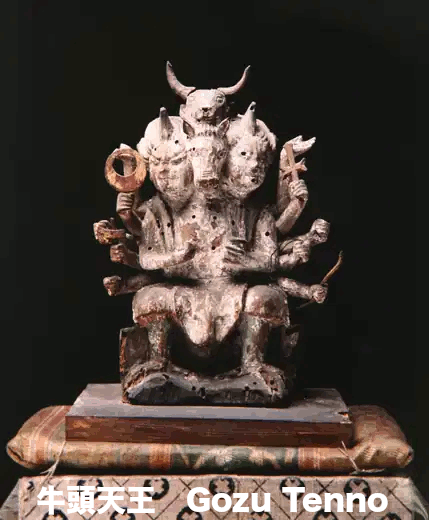Gozu Tenno is a Kishin (demon god) that appears in various Japanese religions and beliefs. He is primarily worshipped as a deity who governs epidemics, or as a guardian deity who pacifies epidemics. I would like to consider the contradictory nature of Gozu Tenno.
Origins and Nature of Gozu Tenno
Originally, Gozu Tenno was not a Japanese god; he was imported from Indian Buddhism, passing through China. There is also a theory that he was influenced by Taoism. His role was said to be that of a deity who judges the dead, with connections to figures like Yama (Enma Daio) and the rakshasa. Gozu Tenno is feared as a strict deity who brings epidemics.
The Dual Nature of Gozu Tenno
In Japan, Gozu Tenno is regarded as the god of epidemics. In 869, Gozu Tenno brought a plague to Kyoto. On June 7 of that year,
The people in Heian period sent three portable shrines to the Shinsenen, which was a sacred garden at the time.
They erected 66 festival floats, corresponding to the number of provinces in the country, each about 6 meters tall, to pray for national peace and the elimination of misfortunes.
This ritual aimed to appease Gozu Tenno’s anger in order to avoid the plague.

The Teared Gozu Tenno.”
Gozu Tenno is not merely a god who brings calamities; when properly worshipped, he is also a guardian deity who protects people and pacifies epidemics. His dual nature—spreading disease and soothing it—explains why he is revered rather than simply feared.
Gozu Tenno is the deity of Yasaka Shrine in Kyoto, and the grand festival for driving away epidemics later evolved into the famous Gion Matsuri.
Is Gozu Tenno Susanoo no Mikoto?
As mentioned earlier, Gozu Tenno is a kishin who spreads epidemics. On the other hand, Susanoo no Mikoto in Shinto is also a tumultuous deity who causes storms and can bring about or quell diseases.
Both are feared yet worshipped as gods who can calm disasters when properly honored. They share a dual nature, embodying both a fierce character and protective powers.
Syncretism of Shinto and Buddhism
In Shinto, Susanoo no Mikoto is characterized by his wild nature, engaging in various troubles and misdeeds in mythology. At the same time, he also displays heroic traits, such as defeating the eight-headed serpent, Yamata no Orochi. While being a god of disasters,
Susanoo is also regarded as a guardian of agriculture and a symbol of purification and rebirth. He provides blessings similar to those of Gozu Tenno.
In other religions, it is convenient and understandable for the Japanese to identify gods and Buddhas with similar characteristics as the same entities.
The Promotion of Buddhism by the Authorities
On the other hand, as Buddhism spread, powerholders began to embrace it. This led to a situation where Shinto and Buddhism influenced each other, resulting in an ambiguous boundary between the two. A good example of this phenomenon that remains today is Tsurugaoka Hachimangu in Kamakura.
Originally a Shinto shrine, Tsurugaoka Hachimangu has come to function similarly to a Buddhist temple, creating a space where both Shinto deities and Buddhist figures are worshipped together.
Summary
Gozu Tenno was regarded as a god who either caused epidemics or calmed them. The deity is viewed as a god of epidemics stemming from the traditions of Indian and Chinese Buddhism.
In Japan, particularly during the Heian period, he was worshipped in Kyoto, where festivals were held to pacify epidemics. This practice ultimately evolved into the famous Gion Matsuri, which continues to this day.
As a deity who both spreads and calms epidemics, Gozu Tenno wields immense power. Therefore, it is essential to conduct festivals to appease him and avoid incurring his wrath. This is precisely why he is referred to as a Kishin (demon god).


コメント